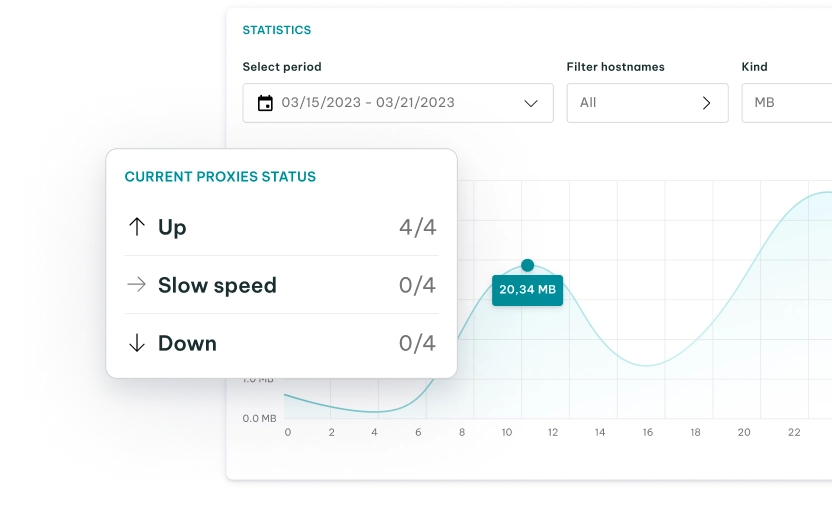All You Need to Know About SOCKS5
Proxy fundamentals

Vilius Dumcius
Maybe you tried to access a website only to be met with the message, “ This content is not available in your location ,” or you may have inadvertently violated the terms of service on your favorite online platform, causing a subsequent IP ban that prevents you from creating new accounts.
A proxy server can come in handy in all the aforementioned situations. However, there are different types of proxies, i.e., HTTP proxies, HTTPS proxies, and SOCKS5 proxies. While the underlying principle of operation is the same, these proxy servers differ in handling traffic, giving each an edge over the others in specific situations.
This article will dissect SOCKS5 proxies in detail, helping you understand how these servers work and how they differ from other proxies. By the end, you’ll have understood the situations where you should and shouldn’t use a SOCKS5 proxy server . Keep reading below.
What Is SOCKS5 Proxy?
Before things get complicated, let’s first understand what a proxy server is and how it works. In simple terms, it is a tool that lets you connect to the internet via an alternate IP address, effectively bypassing any restrictions on your regular IP .
Think of a proxy as a middleman for your internet connection. When you connect to the web via a proxy, your computer will route your network packets to the proxy server address. Depending on the type that you opt for, it may modify the packets before routing them to the target server.
And as far as the target host is concerned, the traffic comes from the proxy’s IP address, not your own. This can help you bypass internet restrictions, improve privacy, and evade detection when using automated tools online.
So, then, what is a SOCKS5 proxy?
To understand what this is, you must know that there are different classifications of proxies, and one is based on the type of internet traffic a particular server is designed to handle. Here are the different types of proxies depending on the type of internet traffic they process:
- HTTP proxies
HTTP proxies are designed to handle HTTP protocol, which is the most widely used on the web. Since these proxies handle unencrypted traffic, they are best suited for general web browsing, content filtering, caching, and anonymity.
- HTTPS proxies
HTTPS proxies, on the other hand, are designed to handle encrypted HTTPS traffic, which is a secure version of HTTP. These proxies can encrypt and decrypt traffic using SSL certificates, making them ideal for secure web browsing, filtering, and monitoring, as well as other applications that require secure connections.
- SOCKS5 proxies
Now, to the crux of our discussion: SOCKS5 proxy servers. Unlike HTTP and HTTPS proxies, a SOCKS proxy server operates closer to the transport layer . As such, they can handle all types of network traffic, not just HTTP and HTTPS. The latest version, SOCKS5 proxies, can handle UDP protocol and TCP connections. For this reason, SOCKS5 proxies are suitable for a wide range of applications, including peer-to-peer networks and online gaming.
SOCKS5 Proxy vs. Other Proxies
To better understand SOCKS5, you’ll first need to compare it to other proxies to see how well it performs. This way, you can figure out whether it’s a good fit for you.
- SOCKS5 proxy versus HTTP proxy
HTTP (HyperText Transfer Protocol) is the most common protocol on the internet, with HTTPS serving as its secure extension. Read this blog on HTTP vs HTTPS proxies to understand the difference. Although HTTP proxies are great for unblocking some geo-restricted content, they don’t necessarily work well with other protocols. On the other hand, the SOCKS protocol proxies work well with different protocols without interpreting the traffic between a device and the server.
- SOCKS5 proxy versus VPN
A VPN (Virtual Private Network) uses tunneling technology to provide users with a private, secure, and encrypted connection over a public network. At the same time, a VPN also masks your IP address by routing your traffic through a remote secure server operated by the VPN provider. As a result, your data is safe from hackers, your connection remains secure, and your IP address remains anonymous. Although SOCKS5 is generally faster than a VPN and also alters your IP address, it does not encrypt your data.
Benefits of Using SOCKS5 Proxies
Up to this point, you understand how a SOCKS5 proxy works, as well as how it differs from HTTP/HTTPs servers and VPNs. You may be wondering what you stand to gain by using a SOCKS5 proxy. Here is what you need to know:
- IP address protection
Like all other proxy servers, a SOCKS5 proxy will mask your IP address. Say you wanted to connect to Instagram via a SOCKS5 proxy—it will hide your IP address so that Instagram servers will interact with the proxy’s IP address in place of yours.
- Internet restrictions bypassing
Internet restrictions can be frustrating. Although many of these restrictions stem from legitimate reasons, such as copyright regulations and government policies, the effect on you, the consumer, remains the same. Fortunately, a SOCKS5 proxy can help you go around such censorship. All you have to do is select a SOCKS5 proxy from a location with access to your desired content.
- Better compatibility with most applications
As we mentioned earlier, a SOCKS5 proxy operates at the transport layer (layer 4 of the OSI model . Therefore, this proxy does not modify packet headers, making it more versatile than HTTP/HTTPS proxy servers on multiple levels. To begin with, a SOCKS5 proxy is protocol-agnostic, which means it works with all kinds of traffic (HTTP, HTTPS, FTP, IMAP, SMTP, UDP, and TCP). Learn more about TCP connection in our TCP checker. Therefore, SOCKS proxies offer significantly better compatibility compared to HTTP and HTTPS proxies.
- Improved performance
Since a SOCKS5 proxy does not modify data packet headers, it is better positioned to offer better performance compared to other proxies. Most proxy servers, including HTTP and HTTPS, modify network packets, increasing the chance of mislabeling or misrouting data. There is a lower margin of error with a SOCKS proxy, but this comes at the cost of privacy and security since headers contain your personal information , which can be easily identified.
How to Set Up a SOCKS5 Proxy
Now that you know the benefits of using a SOCKS5 proxy, you may want to learn how to set one up yourself. Here are step-by-step guidelines covering the configuration process for Windows and Mac OS devices.
How to Set Up a SOCKS5 Proxy on Windows
1. Press the Windows + I buttons to open Windows Settings and select Network & internet (1) .
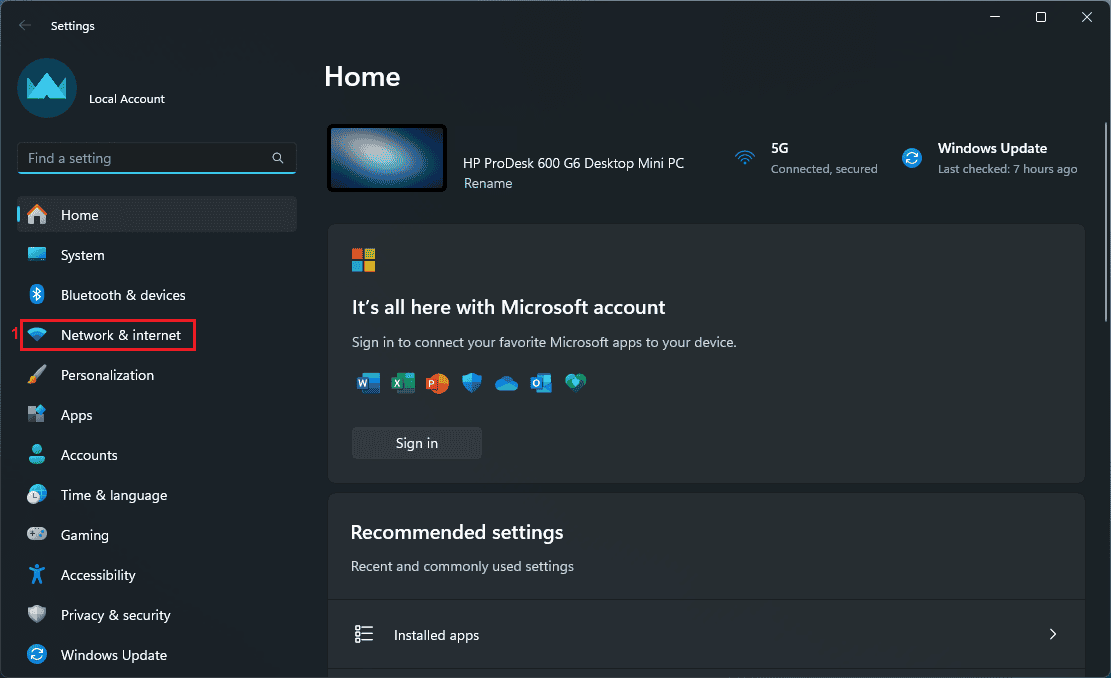
2. Scroll down and click on Proxy (2) .

3. If you want Windows to automatically recognize your proxy settings, toggle Automatic Proxy Settings (3) to On and close the Settings window.
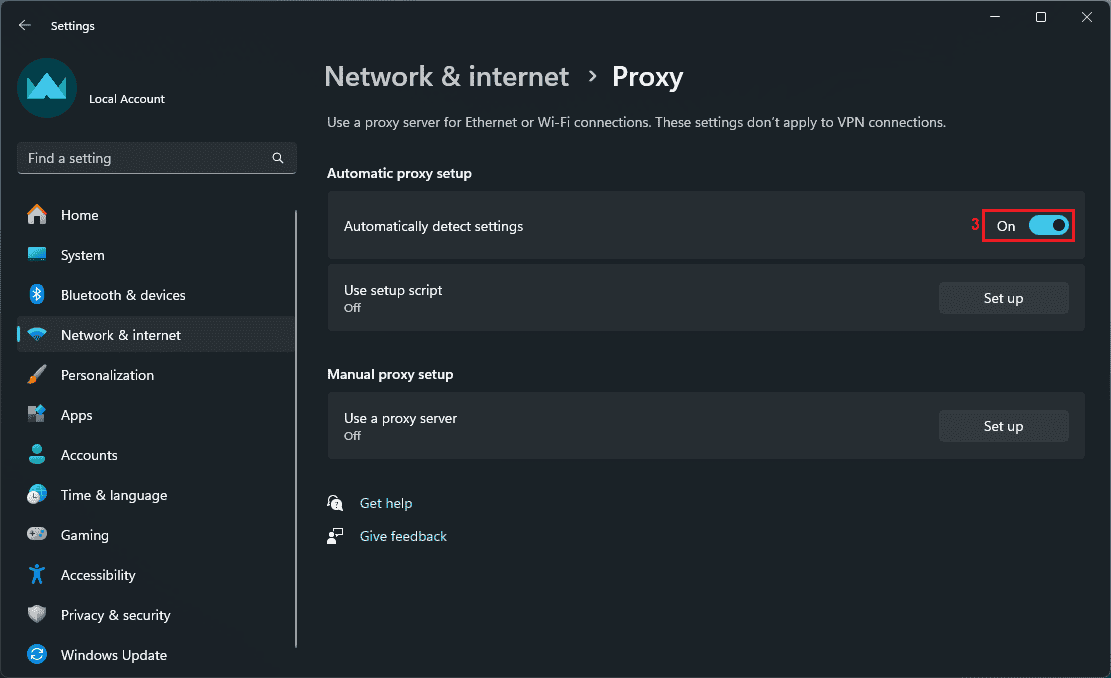
4. If you want to manually configure your SOCKS5 proxy details, set this option to Off (4) . Click the Set up (5) button under the Manual proxy setup section.
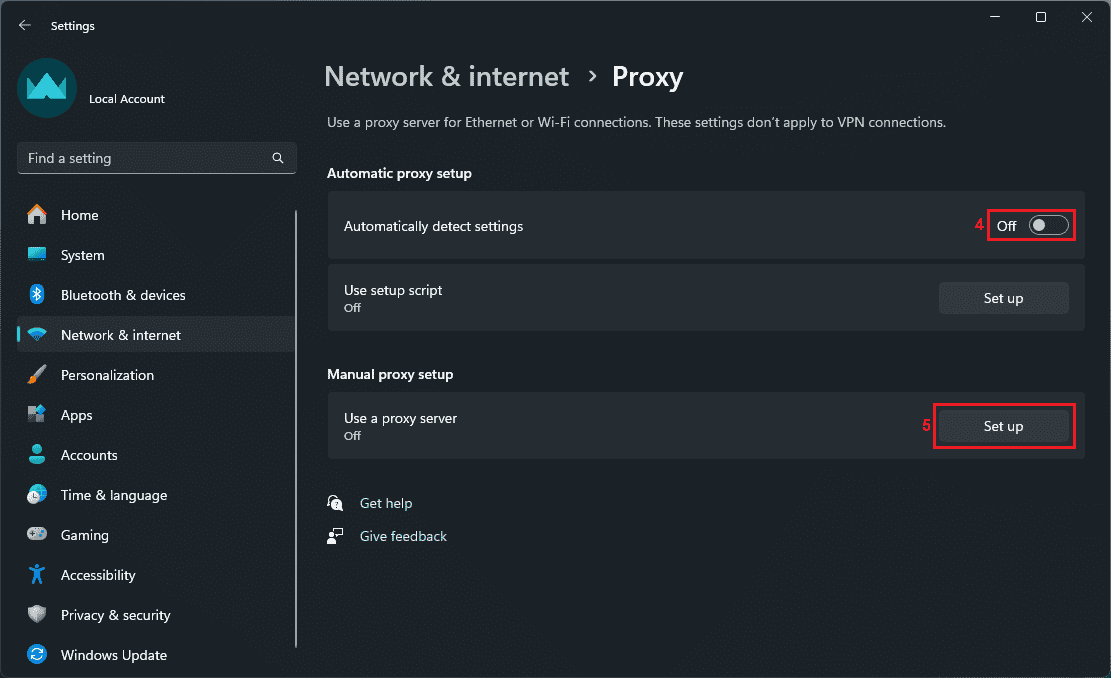
5. Toggle the button below Use a proxy server to On (6) and enter your proxy server’s IP address (or hostname) and port (7) . Click Save (8) to apply the changes.

How to Configure a SOCKS5 Proxy on MacOS
1. Click on the Apple logo (1) on the top left corner of your screen and select System Settings (2) .

2. Click on Network (3) in the quick menu and select the network interface (4) you’re currently using.
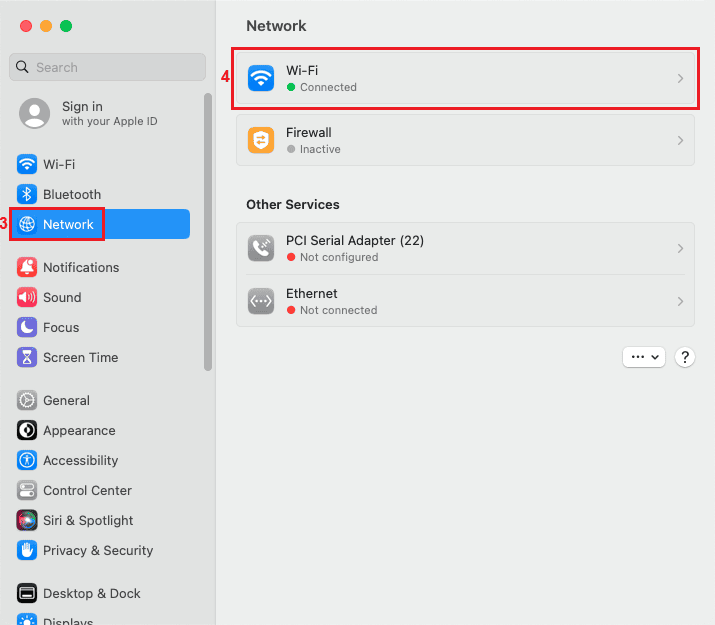
3. Click on Details (5) .
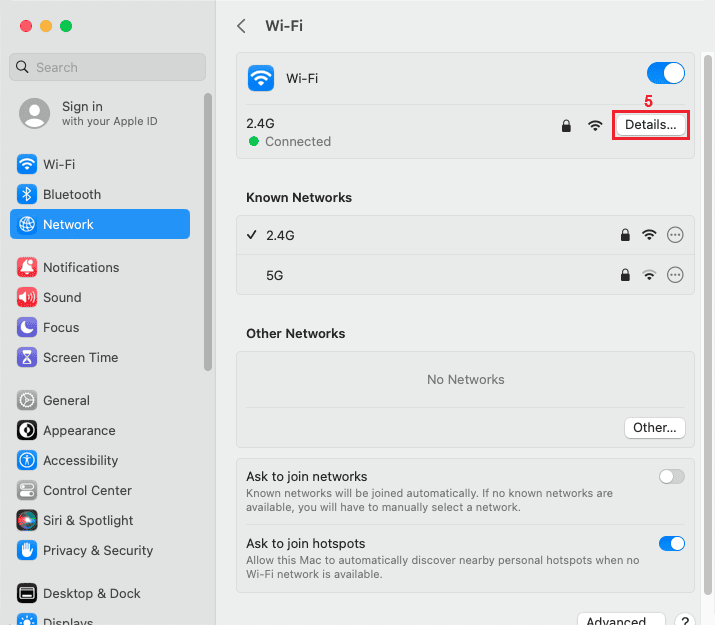
4. Click on Proxies (6) in the quick menu.
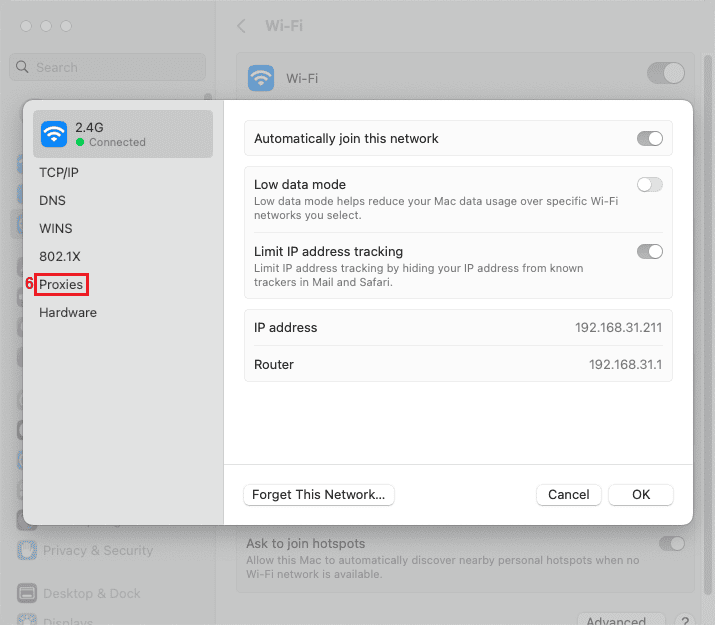
5. Toggle the button (7) next to SOCKS proxy.

6. Enter the IP address and port (8) of your SOCKS5 proxy and click OK (9) .
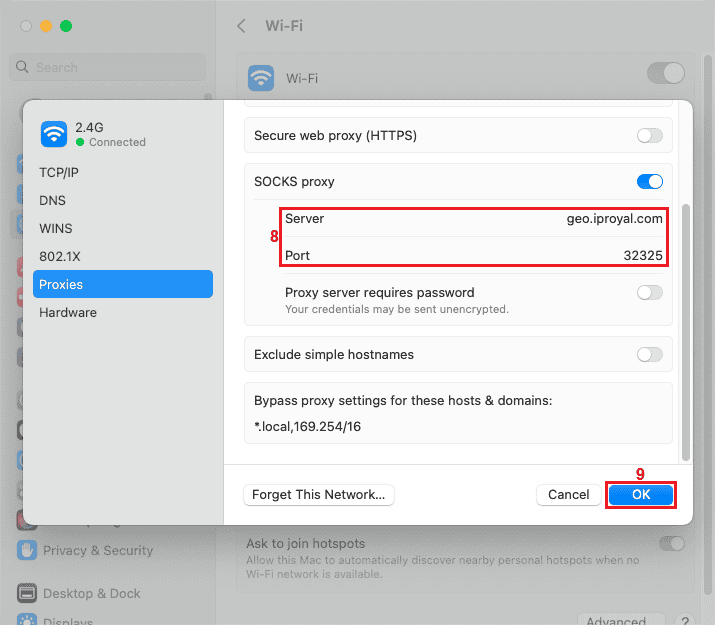
Common Authentication Methods for Your SOCKS5 Proxy
Depending on the proxy provider you opt for, you may have multiple authentication methods at your disposal. Username/password authentication is the most common. For most devices, you’ll be prompted to authenticate your proxies every time you connect to the web, which may be inconvenient.
To avoid this, consider whitelisting your SOCKS5 IPs with your provider. IP whitelisting is quite straightforward compared to other authentication methods because you automatically configure your IP address to use a SOCKS5 proxy, bypassing the need to enter your authentication details.
Are Free SOCKS5 Proxies Worth It?
You may be tempted to work with free SOCKS5 proxies. While it’s understandable, this almost always turns out to be a wrong move for many reasons. For one, running a SOCKS5 proxy demands a lot of resources, and since you are not paying for the service, the provider may be inclined to raise funds from other less-than-legitimate means. Some may collect your private information and sell it to targeted advertisers.
On the other hand, some free SOCKS5 proxies are outright scams run by hackers intending to infect your device with malware. Finally, the performance you’ll get from a free SOCKS5 proxy is likely to be mediocre compared to premium IPs.
IPRoyal - Your Ultimate Proxy Solution
At IPRoyal, we provide private and secure proxies at prices that are suitable for all businesses. All our services, including residential proxies , allow SOCKS5 connections, meaning that your online operations will stay safe and anonymous. For more information, get in touch with our team today!
FAQ
How do I set up SOCKS5 proxies on an iPhone?
Setting up a SOCKS5 proxy on your iPhone is relatively straightforward, especially when using proxy management tools such as Shadowrocket, which lets you easily manage SOCKS5 proxies on your iOS device.
Can SOCKS5 be detected?
SOCKS5 proxies are harder to detect because they do not modify packet headers. This is contrary to HTTP and HTTPs proxies which may leave traces on data packet headers when they change them. As such, SOCKS5 proxies offer better anonymity.
How do I know if a SOCKS5 proxy is working?
The easiest way to know if your SOCKS5 proxy is working is to check the IP address via our IP Lookup page. If the displayed address coincides with the proxy IP, then it is working.
